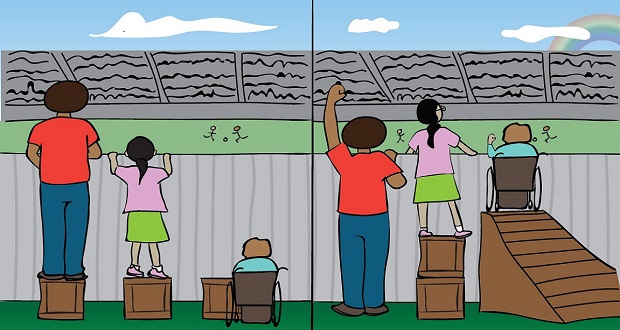Defining DEI
The concepts of “diversity,” “equity,” and “inclusion” get so often grouped together, and after a while you might have a hard time differentiating between them. You may look at the make-up of your unit's students, faculty or staff and believe your unit to be diverse. However, it is important to remember that diversity extends beyond just what we can see.
DIVERSITY refers to all aspects of human difference, and each person is a unique combination of those aspects
You might differ from others in all sorts of ways, including (but not limited to) things like race, ethnicity, creed, color, gender, sexual orientation, socioeconomic status, age, culture, or national origin. You might also differ in aspects like language, physical abilities, intellectual tradition, military/veteran status, political perspective, and other life experiences.
A diverse environment is one where a variety of individuals, groups, and/or communities with different characteristics exist together.
Diversity is essential, but it is not sufficient. Your team can be diverse and yet not inclusive...
INCLUSION refers to the kind of active, intentional, and ongoing engagement with diversity that cultivates an environment where any individual or group can feel welcomed, respected, supported, and valued
In simplest terms, inclusion is getting the mix to work together. More deeply, inclusion is when everyone feels like they belong, like they are able to fully participate and achieve their potential.
You might notice that this definition is centered on impact (whether or not the people in your unit feel valued) rather than intent (what you are or aren’t doing). This highlights how important it is for you to learn from your unit’s many stakeholders--not just leadership or committee members--about what is and is not working!
Just as it is possible to have a diverse group that is not fully inclusive, it is possible to have an inclusive environment that isn't fully equitable...
EQUITY refers to creating and upholding the kinds of fair and just practices and policies that ensure all campus community members can thrive
Equality implies treating everyone as if their experiences are exactly the same, which simply isn’t true. Equity means acknowledging that different people will have different needs in order to have the same access to opportunities. Take a look at the image below:

Photo: equitytool.org/equity/
The picture on the left depicts equality (uniformity) but not equity. The three people featured have very different needs, and so by measuring everyone according to only the first person's needs they actually end up disadvantaging the second and third person. It may not have been intentional at all, but that is the effect.
The picture on the right is a depiction of equity: the varying needs of the three people are addressed to ensure each of them can watch the game if they want to. It doesn't enforce outcome--they still have to climb/roll up, after all--but it does ensure they can have access.
A brief note on historical inequity:
Because so many times existing (historical) structures and systems have marginalized groups by failing to consider their needs, changes must be made to create a more equitable learning environment for all university community members. This is hard for many, especially if their experience most closely resembles the first person in the image above. It might seem to them that the others are getting ‘unfair’ help, and that they are being punished (their step was taken away, after all). But it is this accommodation that in fact ensures the fairness of access for all.
Looking for a more comprehensive list of terms and definitions?
View the Equity, Diversity & Inclusion Glossary of Terms
Anticipating skepticism / pushback concerning the changes your team will need to make to your unit's practices or policies?
